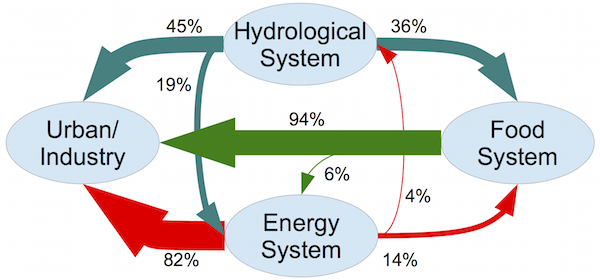The water-energy-food nexus has become a popular buzz-word in the sustainability field. It aims to capture the idea that water, energy, and food challenges are intertwined, and that shocks to any one can precipitate problems to all three.
I’ve often wondered how closely these three are intertwined though. Water is certainly needed for energy (for thermoelectric cooling and hydropower), but the reverse link (mostly pumping) seems a lot weaker. Water is also needed for food production, but is food needed for water availability? Energy and food have some links, with a fair amount of energy needed to produce fertilizer, and a some “food” production actually going to biofuelds, but the sizes aren’t clear.
Below is my attempt to show these flows, for the United States:
It seems to me, based on this, that this is less a nexus than water-centered system. Every drop of water is fought over for energy, food, and urban production. It’s less a interconnected nexus than a hub-with-spokes. A way to recognize that water is at the center of it all.
Sources:
– Hydrological flows: Total water (GW+SW) extractions from USGS. Food system only has irrigation and livestock; energy only has thermoelectric. The rest make up the difference.
– Energy system flows: Food system energy from Canning, P. 2010. Energy Use in the U.S. Food System. USDA Economic Research Report Number 94; “In 2010, the U.S. water system consumed over 600 billion kWh, or approximately 12.6 percent of the nation’s energy according to a study by researchers at the University of Texas at Austin.” from http://www.ncsl.org/research/environment-and-natural-resources/overviewofthewaterenergynexusintheus.aspx “Energy consumption by public drinking water and wastewater utilities, which are primarily owned and operated by local governments, can represent 30%-40% of a municipality’s energy bill.” from https://fas.org/sgp/crs/misc/R43200.pdf; remainder to 100%.
– Biofuels: 18.38e6 m^3 ethanol + 1.7e6 m^3 biodiesel, at a density of 719.7 kg/m^3 is 14.45e6 MT.
– Remainder of food: https://www.ers.usda.gov/topics/international-markets-trade/us-agricultural-trade/import-share-of-consumption.aspx reports 635 billion pounds consumption, 81% of which was domestically produced.


0 responses so far ↓
There are no comments yet...Kick things off by filling out the form below.